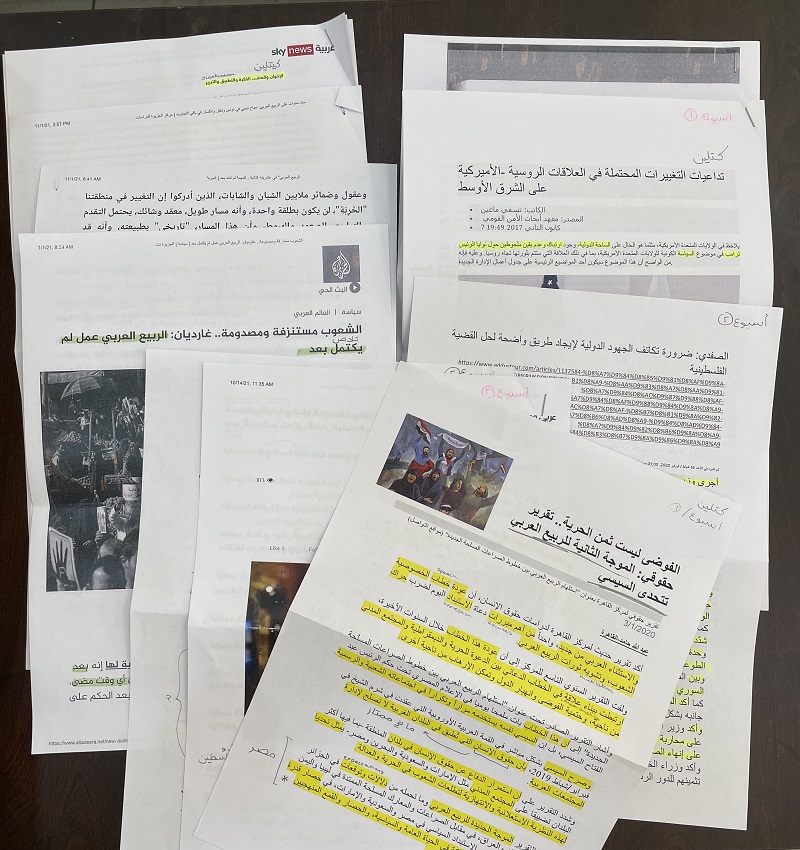Written by Caitlyn Aldersea, (University of Denver), Student Correspondent for CET Jordan, Fall 2021
Read anything interesting in the news lately? While that question probably comes across as an awkward attempt to make small talk, this inquiry actually sits at the center of my Arabic content course “Current Issues in Arabic Media.” And, funny enough, it is far more interesting to answer than you may expect.
While mastering the Arabic language sits at the center of my decision to come to Jordan, another reason I chose CET was because of its emphasis on cultural immersion through academics. You can learn about Middle Eastern politics, religion, news, and society through elective courses often taught in Arabic by Jordanian professors, providing a different perspective to the ones we are taught in American universities. This was important to me and my interests in journalism because the most frequent piece of advice I receive as a Journalism minor is to practice rather than study journalism. It is one thing to know all of the AP formatting exceptions, but it is another to know how to interview people or recognize reporting biases (even in a different language) or how to report on issues from outside your own cultural context. This takes time, practice, and a bit of a challenge which is exactly what my Arabic elective “Current Issues in Arabic Media” provides.

A selection of news articles we have read in the last three weeks
Occurring twice a week with students from varying Arabic linguistic levels, the course emphasizes “big-picture” comprehension rather than vocabulary memorization. The week’s news articles are carefully selected; key ideas are highlighted and accompanying relevant vocabulary lists provided so that students can grasp the main ideas of the article. For example, a five-page article on the Arab Spring can quickly dwindle down to less than a page of highlighted content which summarizes the main arguments, ideas, and biases. But that does not mean it is easy. Rather, you are able to cut through to the hidden messages of an article, prompting you to ask what purpose the article serves, who it is in support of, is it possible to have neutral news, or how would a U.S.-based news organization report on the same topic? In class, each student is responsible for discussing their assigned article which then opens the floor to a seminar-style conversation on Arabic media strategies, biases, and political contexts.
In these discussions, you often realize the parallels and contrasts of US and Arab media strategies. Basic facts may be the same, but even in translation some of the more nuanced arguments are not translatable or make different (even contradictory) points on the same issue. While my course has not yet had a field-based experience, our first planned excursion is to an Arab television news agency. And with this fieldtrip comes the opportunity to ask the hard questions: what compels you to interview one person over another? How does the news agency’s structure impact the reporting style?
As an American, this class has changed my perspective of U.S. media coverage on international events, particularly in the Middle East. Content discussing the Arab Spring, democracy-building, the Israel-Palestine conflict, and even U.S. politics can be presented in such a different manner that you begin to wonder what the consequences are on audience opinions. And these differences in reporting style are exactly why it is important to engage with such news. I have not only learned to recognize biases or pinpoint main points in Arabic news, but also have restructured the way I approach reading news in English. You learn to cut through fluffy language to find the hidden messages of the reporter, consistently asking yourself what is the main argument here? And that is what makes it so fun to answer the question read anything interesting in the news lately? Because, after this class, I will always say yes – whether reading it in Arabic or English, there is always something that will capture your attention if you just know how to read between the lines.

Basic notes for an upcoming presentation on the Arab Spring and the differences in revolution outcomes from Tunisia to Syria